
Join the Sunshine Coast Marathon
Join the Sunshine Coast Marathon with PEAK Sports and Spine Centre: Run with a Winning Team and Enjoy Exclusive Perks!Are you ready to challenge...
Read moreWhile oncology may not always be the focus in every clinic, many cancer survivors pass through our doors, and understanding how exercise can aid in their recovery is essential. In this post, we’ll explore the latest research on exercise prescription for cancer patients, focusing on common cancers like breast, prostate, and colorectal, and how tailored exercise plans can improve outcomes and quality of life.
Cancer is a disease that affects not only the person diagnosed but also their loved ones, often leaving lasting physical and emotional impacts. Whether it’s firsthand experience or witnessing a loved one’s battle, the effects of cancer are undeniable. For example, breast cancer became the most commonly diagnosed cancer in Australia in 2021, with treatment protocols often involving surgery, chemotherapy, and radiation. Many patients experience debilitating side effects, from fatigue and bone loss to lymphedema and nerve damage. However, research consistently shows that exercise has the power to mitigate these side effects, improve physical and mental health, and ultimately contribute to better long-term survival outcomes.
Exercise has been shown to help cancer patients recover more quickly from surgery, maintain muscle mass during chemotherapy, combat fatigue, and reduce the risk of cancer recurrence. By incorporating a carefully structured exercise regimen into cancer care, healthcare providers can offer survivors a way to regain their strength, boost their immune system, and improve their overall quality of life.
Breast cancer is the most commonly diagnosed cancer in Australia and the leading cancer among women. Every day, approximately 57 Australians are diagnosed, totaling over 20,000 cases annually, including around 200 men.
Breast cancer is staged based on how far it has spread:
Treatment
Treatment often involves surgery, chemotherapy, radiation, Immunotherapy and hormone therapy. Each treatment presents unique challenges for exercise prescription:
For breast cancer survivors, exercise guidelines generally emphasize safe, moderate-intensity aerobic and resistance exercises, while taking into account specific concerns like lymphedema, peripheral neuropathy, bone health, and the patient’s stage of recovery. Individualized exercise prescription is crucial to balance the therapeutic benefits of exercise with the potential challenges posed by cancer treatment.
Exercise offers numerous benefits for breast cancer survivors, including improved fatigue management, enhanced aerobic capacity and muscular strength, and significant psychological improvements that boost quality of life. Regular physical activity also lowers the risk of chronic diseases, such as cardiovascular conditions, and has been shown to decrease the recurrence rates of breast cancer. Additionally, exercise contributes to increased survivorship, helping patients maintain better overall health and well-being during and after treatment. General guidelines can be seen in the figure below.
When prescribing exercise for breast cancer survivors, several special considerations must be taken into account. Lymphedema can cause symptoms like heaviness, pain, tightness, and reduced range of motion in the limb, as long as this is monitored, exercise has been shown to be beneficial. Peripheral neuropathy may require balance training and a careful assessment of fall risk, with modifications to reduce injury risk during resistance and aerobic activities. For patients with bone metastases, aerobic and resistance exercises can be beneficial, but must avoid affected areas and minimize strain on the bones. Cardiotoxicity symptoms, such as shortness of breath, fatigue, weight gain, and edema, should be monitored closely during exercise to ensure safe participation. Lastly, Cording (Axillary Web Syndrome), common after lymph node surgery, can result in pain and limited shoulder movement, requiring exercises that gently improve range of motion without aggravating the condition.
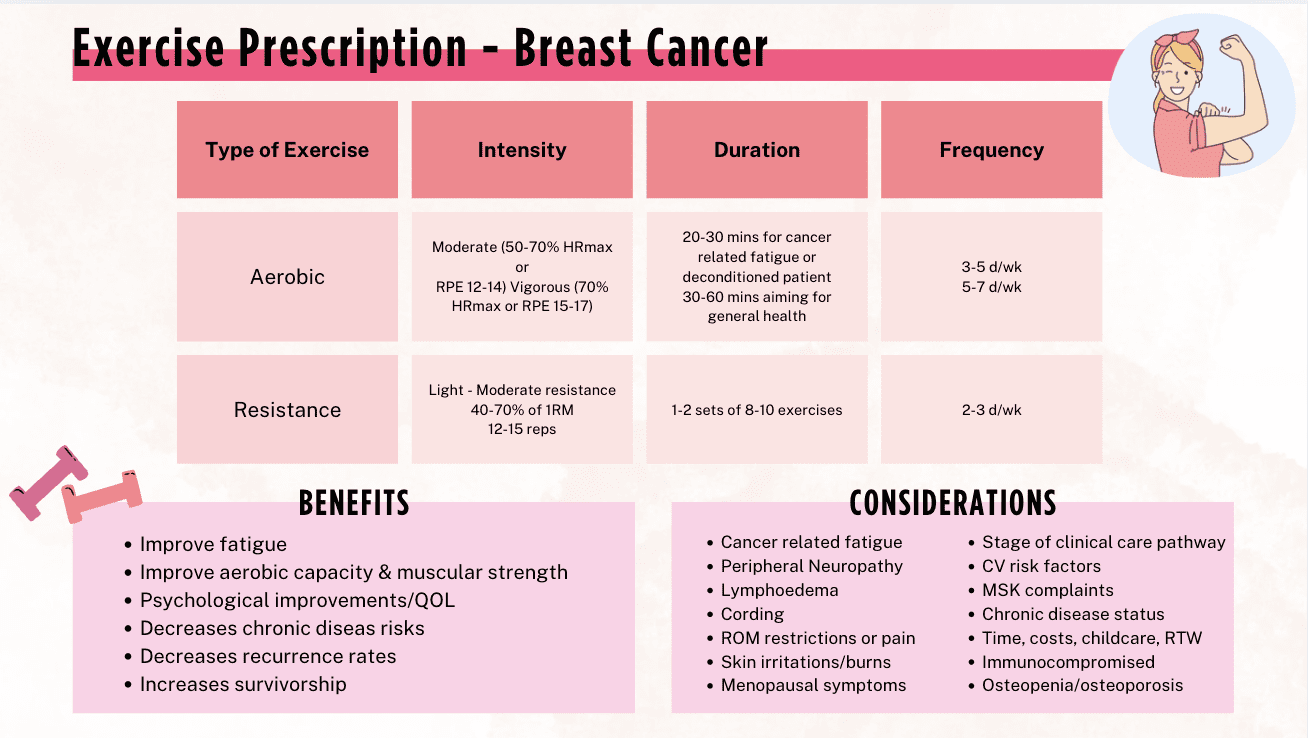
Prostate cancer (PCa) is the most commonly diagnosed cancer in men and the second most commonly diagnosed cancer overall, after breast cancer, accounting for around 13% of all cancer diagnoses. In Australia, more than 90,000 men have been diagnosed with prostate cancer in the past five years, and there are currently over 200,000 prostate cancer survivors in the country. The five-year survival rate for prostate cancer is high, at approximately 95%. Prostate cancer is staged using the TNM system, where T describes the depth of tumor invasion, N indicates whether the lymph nodes are affected, and M indicates whether the cancer has spread to other parts of the body. Stages range from T1, where the cancer is not detectable during a physical examination, to T4, where cancer has spread to nearby organs. Understanding these stages is crucial for determining treatment and prognosis for individuals living with prostate cancer.
Prostate cancer, often diagnosed in older men, presents its own set of challenges. Early-stage prostate cancer may involve monitoring rather than immediate treatment. However, for those undergoing treatments like surgery (e.g., radical prostatectomy), radiation (including external beam radiation therapy (EBRT) and internal radiation therapy (brachytherapy)), and hormone therapy (such as androgen deprivation therapy (ADT) or orchidectomy), exercise prescription becomes crucial for managing side effects. These treatments can cause a range of issues:
Exercise recommendations for prostate cancer survivors have evolved significantly. Research shows that moderate to high-intensity exercise, including both aerobic and resistance training, can be highly beneficial. It helps improve bone health, mitigate the effects of testosterone suppression, and support overall physical function. This approach is especially effective when combined with the management of treatment side effects, contributing to improved survivorship and quality of life.
When prescribing exercise for prostate cancer survivors, several factors must be considered to ensure safety and optimize outcomes. Densitometry and antiresorptive therapy are important for monitoring and managing bone health, particularly in patients undergoing hormone therapy (ADT), which can lead to bone density loss. Adequate intake of vitamin D and calcium is essential to support bone health, while sufficient protein intake is crucial for maintaining muscle mass and strength, especially during and after treatment.
For patients with bone metastases, exercise should be chosen carefully to avoid further injury. Exercises that involve high torque and rotational movements should be avoided, especially if metastases are in the pelvis, femur, spine, or upper body. In addition, it’s also important to encourage smoking cessation, as smoking can weaken bones and slow recovery. See the image below for guidelines to exercise prescription.
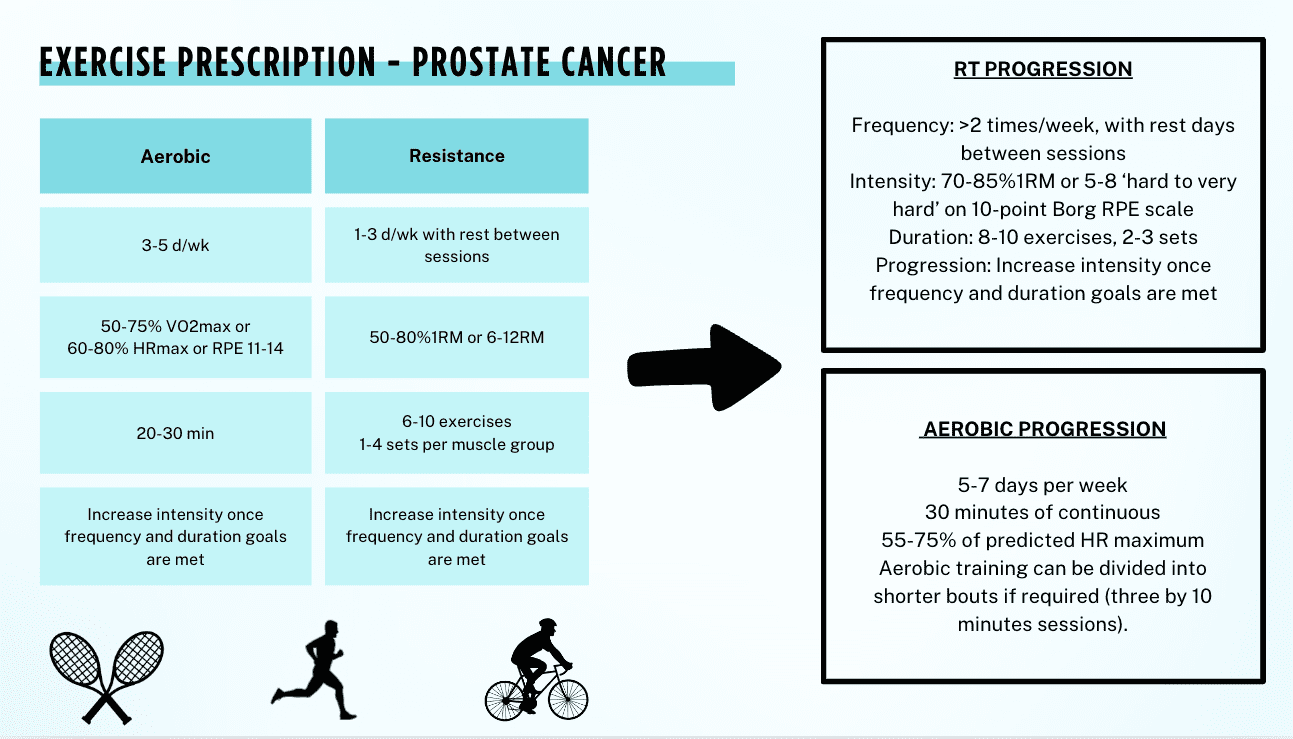
Each year, around 15,500 Australians are diagnosed with bowel cancer, which is most common in individuals over 50, though it can occur at any age. By the age of 85, 1 in 20 people will be diagnosed. Approximately 90% of bowel cancers are adenocarcinomas, with small bowel cancer being rare. The 5-year survival rate is about 70%. Bowel cancer is staged as follows: Stage 1 (tumour in the lining of the bowel), Stage 2 (tumour spread to the bowel walls), Stage 3 (spread to nearby lymph nodes), and Stage 4 (spread to other body parts). Radiation therapy is not used for colon cancer, although it may be used for rectal cancer.
Treatment options for colorectal cancer include a combination of surgery, radiation, chemotherapy, exercise, and immune therapy:
Special considerations for exercise prescription in colorectal cancer include:
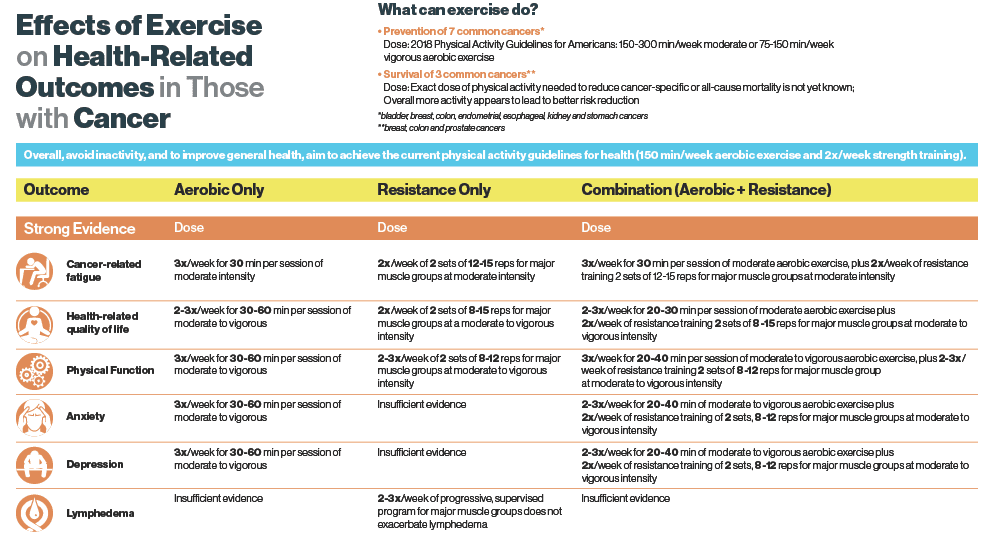
Exercise plays a vital role in cancer treatment and survivorship. By tailoring exercise plans to the individual needs of cancer patients, healthcare providers can help improve physical function, reduce treatment side effects, and enhance overall well-being. Whether it’s managing fatigue, improving bone health, or enhancing immune function, the benefits of exercise for cancer survivors cannot be overstated. For cancer patients and survivors, a structured and evidence-based exercise plan can be an essential part of the recovery journey.
If you or someone you know is undergoing cancer treatment, be sure to consult with a healthcare provider to develop a safe and effective exercise plan tailored to their needs.

Join the Sunshine Coast Marathon with PEAK Sports and Spine Centre: Run with a Winning Team and Enjoy Exclusive Perks!Are you ready to challenge...
Read more
At PEAK, we believe in supporting our athletes to achieve experiences not felt possible. We know that every step, every challenge, and every finish...
Read more
Why You Should Join Us! At PEAK, we believe in supporting our athletes to achieve experiences not felt possible. We know that every step, every...
Read more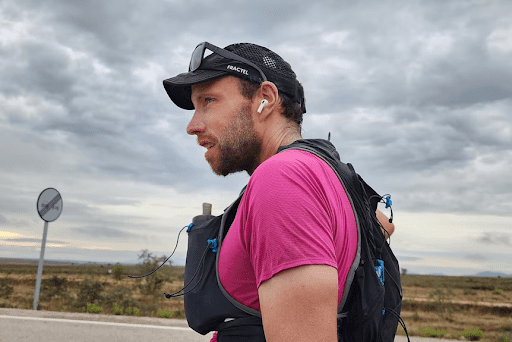
When most people talk about going the distance, they’re thinking a marathon. Tim Franklin? He took it several steps further — 26,000 kilometres further,...
Read more
Why Everyone Should Include It in Their Fitness Routine Strength training is often overlooked, especially by those who prefer cardio exercises or those who associate...
Read more
Diabetes is a chronic condition that can have widespread effects on the body, and one of the most overlooked areas it impacts is the...
Read more
Pain is often perceived as a warning sign that something is wrong in the body. While this can be true in cases of an...
Read more
Choosing His Pain Lleyton, one of our dedicated physiotherapists, recently crossed the finish line of the Tokyo Marathon in 5 hours and 20 minutes—a remarkable...
Read more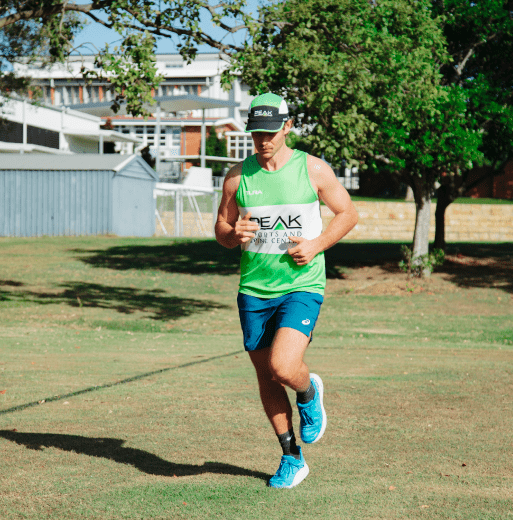
Finding the perfect running shoe can often feel like a challenge—there’s an overwhelming number of options to choose from, and it’s hard to know...
Read more
Insights into PEAK Coach Callum’s Journey! The road to the marathon is no easy feat, but for many, it’s a bucket list item worth the...
Read moreNot exactly what you're looking for?
View all articles

















Can't find what you're after?
View all ServicesOr email the PEAK team at info@peakssc.com.au
To make a booking outside of business hours, please use our form by clicking here.
To make a booking outside of business hours, please use our form by clicking here.